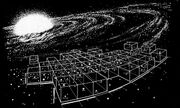No edit summary |
Renegade54 (talk | contribs) m (+ bginfo) |
||
| (5 intermediate revisions by 4 users not shown) | |||
| Line 1: | Line 1: | ||
| − | [[File: |
+ | [[File:The Explored Galaxy.jpg|thumb|The location of Beta Geminorum in "The Explored Galaxy" star chart]] |
| − | '''Beta Geminorum''' (also called '''Pollux''') was the [[star|primary]] of the [[Beta Geminorum system]]. ({{TOS|Who Mourns for Adonais?}}) |
+ | '''Beta Geminorum''' (also called '''Pollux''') was the [[star|primary]] of the [[Beta Geminorum system]] and located in the [[Alpha Quadrant]]. Its location in the [[Milky Way Galaxy]] was depicted on a [[Federation]] [[star chart]] in [[2293]]. ({{TOS|Who Mourns for Adonais?}}; {{film|6}}, ''production art'') |
| + | {{bginfo|In ''The Explored Galaxy'', Beta Geminorum and Pollux were depicted as two distinct stars, even though they were established to be synonymous in "Who Mourns for Adonais?". In the star chart, both Pollux and Beta Geminorum were located between the [[Tholian Assembly]] and [[Romulus]]. Both were identified in {{DS9|Call to Arms}} as being located in the Alpha Quadrant.|According to ''[[Star Trek: Star Charts]]'' (pg. 60), the Beta Geminorum system was located in the [[Beta Quadrant]]. Beta Geminorum was a [[Star Trek: Star Charts#Spectral classification|K-class star]] with a [[magnitude]] of +3, which was ten times brighter than [[Sol]].}} |
||
| − | The location of Beta Geminorum in the [[Milky Way Galaxy]] was depicted on a [[Federation]] [[star chart]] in [[2293]]. ({{film|6}}) |
||
| − | |||
| − | == Background == |
||
| − | === ''The Explored Galaxy'' === |
||
| − | Michael Okuda, the creator of this chart, believed that Beta Geminorum and Pollux were two distinct stars. Working on this belief, he depicted the location of the two stars on the chart. These stars were within the same region of space. As the connection between these names was established in canon, by separating them, Mr. Okuda had retcon the canon. |
||
| − | |||
| − | This chart was also seen in several ''[[Star Trek: The Next Generation]]'' and ''[[Star Trek: Deep Space Nine]]'' episodes set in the [[24th century]], from the year [[2364]] to [[2370]]. These were: {{TNG|Conspiracy|The Measure Of A Man|The Emissary|The Mind's Eye|The Game}} and {{DS9|In the Hands of the Prophets|Cardassians}}. |
||
| − | |||
| − | === ''Star Trek: Star Charts'' === |
||
| − | [[Geoffrey Mandel]], the author of this book, believed that Beta Geminorum and Pollux were the same star. This star was located in the [[Beta Quadrant]]. The star was classified as a [[Star Trek: Star Charts#Spectral classification|Class K star]]. It had a magnitude of -1, which was 100 times brighter than [[Sol]]. (page 60) |
||
== External links == |
== External links == |
||
Revision as of 14:09, 12 March 2013

The location of Beta Geminorum in "The Explored Galaxy" star chart
Beta Geminorum (also called Pollux) was the primary of the Beta Geminorum system and located in the Alpha Quadrant. Its location in the Milky Way Galaxy was depicted on a Federation star chart in 2293. (TOS: "Who Mourns for Adonais?"; Star Trek VI: The Undiscovered Country, production art)
In The Explored Galaxy, Beta Geminorum and Pollux were depicted as two distinct stars, even though they were established to be synonymous in "Who Mourns for Adonais?". In the star chart, both Pollux and Beta Geminorum were located between the Tholian Assembly and Romulus. Both were identified in DS9: "Call to Arms" as being located in the Alpha Quadrant.
According to Star Trek: Star Charts (pg. 60), the Beta Geminorum system was located in the Beta Quadrant. Beta Geminorum was a K-class star with a magnitude of +3, which was ten times brighter than Sol.
